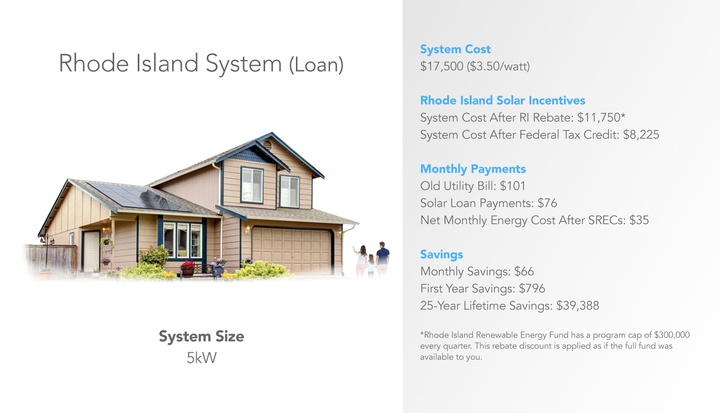
The future looks bright for going solar in Rhode Island. The State’s Renewable Energy Fund (REF) is incentivizing solar energy investments throughout the State through a grant program equivalent to a rebate.
The REF program wants the State’s citizens to discover the financial benefits of investing in solar energy. The State is offering a four-year program paying solar panel purchasers an incentive exceeding that of their current retail electricity rates of $0.19 kWh – the 6th most expensive rate in the nation.
The REF program is reviving the benefits of solar energy throughout Rhode Island. We are going to give you a rundown of your bright future with solar energy in RI.
Benefits of Going Solar in Rhode Island
There are many financial benefits for going solar in Rhode Island. The state is making investing in a solar energy system affordable for homeowners through the following incentives:
Rhode Island Solar Power Grants (Rebates)
As one of the top 10 renewable energy programs in the nation, REF extends homeowners grants (rebates) of $1.15 per watt of solar power energy – capped at $10,000 per home system installed.

The REF program accepts the application for grants on a rolling Block basis every quarter of the upcoming year.
- Each Block is comprised of a $300,000 budget for homeowner grants
- Each quarter, applications from homeowners will be reviewed and approved by REF
- 30 grants to homeowners will be funded to homeowners in each Block in 2017
- 120 grants to homeowners will be funded to homeowners by the end of 2017
Rhode Island Solar Performance Payments
For a small scale, solar project – up to 25 kW – the Renewable Energy Growth Program will pay every homeowner $0.3775 per kWh that their solar panel system supplies to the power grid.
This long-term performance payment is extended for 20 years and is guaranteed money in your bank account. This incentive could add up to $12,735 over the next 20 years.
Federal Income Tax Credit
Receive an automatic Federal Income Tax credit of 30 percent when you purchase your solar energy system.
Rhode Island Solar Property Tax Exemption
Despite the increase in value to your home when you install a solar power system, property tax laws in Rhode Island protect your property from increases in assessments.
Rhode Island Solar Sales Tax Exemption
Your purchase and installation of a solar energy system for your home will be 100 percent exempt from all sales and use tax.
Residual Benefits of Solar Energy
- Cleaner and more sustainable energy source of power
- Stimulation of the State’s job growth in green technology
- Stimulation within energy sectors of the State’s economy
- Increased home value by at least the cost of your system
Solar Loan Expectations
This is what you can expect to receive for a $17,500 loan to purchase a 5kW solar energy system for your home.

- The reduced out-of-pocket cost to $11,750 (after the REF solar grant rebate)
- Federal Income Tax break of 30 percent of the cost of your solar system; reducing the cost of the system to $8,225
- $76 monthly loan payment (reduced to $35 net energy payment after SRECs)
- $452 net spending on energy in the first year
- Energy income continuously offsetting your loan payments
- Expected lifetime savings: $39,500 on a zero-down investment
Now that you understand how much money you can save from going solar in Rhode Island, let’s make sure you receive the most affordable, highest quality solar panel system.
Start Receiving Your Online Solar Quotes
Rhode Island homeowners face many overwhelming and confusing unknowns about how to begin the process of purchasing and installing a solar panel system.
Discover how Solar.com’s online solar quotes easily compare:
- Solar equipment
- Financing options
- Solar installers
All-Inclusive Solar Energy System
While avoiding high-pressure sales tactics, you can select the Rhode Island solar company best qualified to meet your personal and budgetary needs.
- Select the bid making the most sense for your home
- Review and approve the purchase contract terms and conditions online agreed to between you and the solar provider you have selected
- Finalize and sign the purchase contract online
- Watch as we make sure your solar energy system is installed in a timely and proper manner and to your utmost satisfaction
- Rest easy while Solar.com monitors your new solar energy system’s performance. Your satisfaction is our top priority.
Comparing Solar Installers So You Don’t Have To
Discover the ease of going solar with online solar quotes through Solar.com. Because we have designed a one-stop shop for clean energy, our dedicated solar experts are available Monday through Friday between 7:30 a.m. and 7 p.m. See how much you can save with Solar.com, here!


